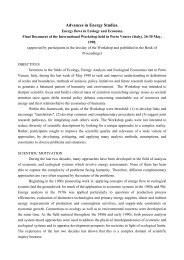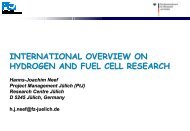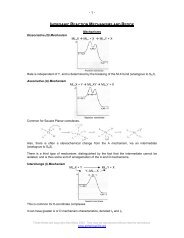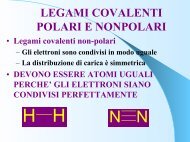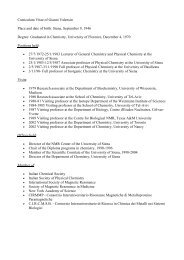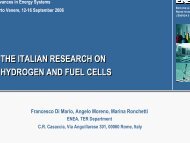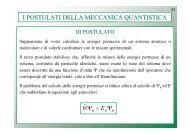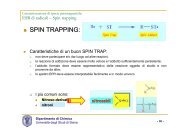Properties of Hydrogel for biomedical applications and Hybrid ...
Properties of Hydrogel for biomedical applications and Hybrid ...
Properties of Hydrogel for biomedical applications and Hybrid ...
Create successful ePaper yourself
Turn your PDF publications into a flip-book with our unique Google optimized e-Paper software.
<strong>Properties</strong> <strong>of</strong> <strong>Hydrogel</strong> <strong>for</strong><br />
<strong>biomedical</strong> <strong>applications</strong><br />
<strong>and</strong><br />
<strong>Hybrid</strong> nanoparticle-polymer<br />
hydrogels<br />
Rol<strong>and</strong>o.Barbucci
<strong>Hydrogel</strong><br />
Is an hydrophilic polymeric<br />
network which may absorb<br />
water in the amount from 10%<br />
up to 100 time its dry weight<br />
polysaccharide<br />
arm<br />
junction point
O<br />
<strong>Hydrogel</strong> Synthesis<br />
COOTBA<br />
n<br />
I - + N<br />
H 3 C<br />
Cl<br />
O<br />
CO O<br />
+ N<br />
H 3 C<br />
+ NH 2 (CH 2 ) 3 NH 2 -<br />
(CH 3 CH 2 ) 3 N +- I<br />
N O<br />
CH 3<br />
n<br />
Characteristics:<br />
-planned <strong>and</strong> reproducible<br />
stoichiometry<br />
-different diamine cross-linking<br />
agents<br />
-predictable cross-linking degree<br />
-predictable properties<br />
O<br />
CO<br />
NH<br />
(CH 2 ) 3<br />
NH<br />
CO<br />
n<br />
Technique to check C.D.:<br />
-N.M.R.<br />
-pH-metry<br />
O<br />
n
The polysaccharide chemistry affects<br />
14000<br />
12000<br />
10000<br />
8000<br />
6000<br />
4000<br />
2000<br />
0<br />
pH 2 pH 7,4 pH 9<br />
Hyal 50%<br />
CMC 50%<br />
AA 50%<br />
10 5<br />
hydrogel<br />
Water Up-take<br />
Confronto<br />
G' CMC 50%<br />
G'' CMC 50%<br />
G' HA 50%<br />
G'' HA 50%<br />
G' AA<br />
G'' AA<br />
G' AA 50%<br />
G'' AA50%<br />
10 6 0.01 0.1 1 10<br />
G',<br />
G''<br />
[P<br />
a]<br />
10 4<br />
1000<br />
<strong>Hydrogel</strong><br />
mechanical<br />
properties<br />
100<br />
10<br />
1<br />
Frequency [Hz]
The crosslinking degree affects:<br />
60000<br />
50000<br />
hydrogel<br />
Water Up-take<br />
(H 2 O)<br />
40000<br />
Hyal<br />
30000<br />
CMC<br />
20000<br />
AA<br />
10000<br />
0<br />
5 50 100<br />
10 5<br />
Confronto<br />
10 6 0.01 0.1 1 10<br />
G' AA 100%<br />
G'' AA 100%<br />
G' AA 50%<br />
G'' AA50%<br />
Cross-linking Degree<br />
G',<br />
G''<br />
[P<br />
a]<br />
10 4<br />
1000<br />
<strong>Hydrogel</strong><br />
mechanical<br />
properties<br />
100<br />
10<br />
1<br />
Frequency [Hz]
<strong>Properties</strong> <strong>of</strong> the gels<br />
-stoichiometry<br />
- planned cross-linking degree (from s<strong>of</strong>t to hard gel)<br />
- sterilizability by EtO<br />
- thixotropy<br />
- coordination towards metal ions (Ag + , Cu 2+ )<br />
- chemical derivatisation (OSO 3- , -CONHCH 3 ,etc.)<br />
- <strong>for</strong>mation <strong>of</strong> predetermined microporosity<br />
- shape memory <strong>of</strong> microporous gels<br />
- amber effect
What is thixotropy?<br />
Thixotropy is the property <strong>of</strong> some<br />
non-Newtonian pseudoplastic<br />
materials that leads to a progressive<br />
decrease in viscosity under a<br />
mechanical stress followed by the<br />
recovery <strong>of</strong> its consistence once the<br />
stress is removed.
Thixotropy <strong>and</strong> hydrogels<br />
INJECTABILIT<br />
Y<br />
MINI INVASIVE<br />
SURGERY<br />
(nucleous polposus<br />
replacement, fillers <strong>for</strong><br />
damaged cartilage,<br />
cosmetic <strong>applications</strong>)<br />
CELL ENCAPSULATION<br />
EASY MIXING WITH<br />
DRUGS<br />
IPN HYDROGELS
G';G" (Pa)<br />
4500<br />
4000<br />
3500<br />
3000<br />
2500<br />
2000<br />
1500<br />
G' AA<br />
G" AA<br />
1270Pa<br />
AA, Hyal <strong>and</strong> CMC based<br />
<strong>Hydrogel</strong>s<br />
are thixotropic<br />
1000<br />
0 200 400 600 800 1000 1200 1400<br />
stress (Pa)<br />
3000<br />
2500<br />
2000<br />
505Pa<br />
G'CMC<br />
G"CMC<br />
1800<br />
1600<br />
1400<br />
1200<br />
1000<br />
505Pa<br />
G'Hyal<br />
G"Hyal<br />
1500<br />
800<br />
G';G"(Pa)<br />
1000<br />
G';G"(Pa)<br />
600<br />
400<br />
500<br />
0 200 400 600 800 1000 1200 1400<br />
Stress(Pa)<br />
200<br />
0 200 400 600 800 1000 1200 1400<br />
Stress(Pa)
Main <strong>biomedical</strong> <strong>applications</strong><br />
<strong>of</strong> polysaccharidic hydrogels<br />
•osteoarthritis therapy<br />
•bioactive coatings (e.g. catheter, stent<br />
•microporous hydrogels <strong>for</strong> the drug<br />
controlled release<br />
•cellular scaffold (artificial organs)
Polysaccharide hydrogels<br />
in osteoarthritis therapy
EFFECT OF HYAL 50%* HYDROGEL ON KNEE OSTEOARTHRITIS<br />
(in New Zeal<strong>and</strong> adult-male rabbits)<br />
Histological analysis<br />
Macroscopic observation:<br />
Hyal<br />
Normal cartilage<br />
Untreated damaged cartilage<br />
native<br />
lesion<br />
Damaged cartilage treated<br />
with Hyal 50%.<br />
The arrow is pointing cells<br />
piled on each other<br />
Damaged cartilage<br />
with Hyal 50%.<br />
At 50 days cartilage lesion <strong>of</strong> the control group appeared covered by a thin <strong>and</strong> slightly<br />
irregular layer <strong>of</strong> fibrous tissue.No samples showed evidence <strong>of</strong> proteoglycans<br />
production in the reparative tissue.<br />
On the contrary Hyal 50% group showed a thick mixed hyaline <strong>and</strong> fibrocartilage layer.
Effect <strong>of</strong> Hyal 50%-IbuLys on knee osteoarthritis<br />
After 50 days treatment<br />
C H 3 C H 3 O<br />
C H C O -<br />
C H 3 C H C H 2<br />
N H 3 O<br />
+<br />
H 3 N C H 2 C H 2 C H 2 C H 2 C H C O -<br />
Ibupr<strong>of</strong>en-lysine<br />
+<br />
Control:<br />
physiological solution<br />
No tissue<br />
regeneration<br />
Treatment with<br />
Hyal 50% loaded<br />
with Ibu-Lys<br />
Treatment with Hyal<br />
50%<br />
Growth <strong>of</strong> new cartilagineous tissue close to the native<br />
cartilage<br />
Both Hyal 50% <strong>and</strong> Hyal 50% loaded with anti-inflammatory drug show the growth <strong>of</strong> new<br />
cartilagineous tissue, which is absent in the control (physiological solution: NaCl 0,9%)
Bone densitometry<br />
For the pain the rabbit does not lay the leginducinga decreasein the bone<br />
density.<br />
Mean percentage <strong>of</strong> the bone density reduction <strong>of</strong> treated site at 30 <strong>and</strong> 50 days in comparison with the<br />
initial one<br />
F1 (whole femur)<br />
T1 (whole tibia)<br />
F2 (distal femoral epiphysis)<br />
T2 (proximal femoral epiphysis)<br />
30 days 50 days<br />
Hyal Hyal+Ibu Hyal Hyal+Ibu<br />
-12.8% -10.2% -24.8% -20.9%<br />
-13.6% -14.8% -29.2% -20.7%<br />
-17.8% -17.4% -34.5% -27.7%<br />
-17.9% -12.8% -31.9% -26.0%<br />
At 30 days: no significant differences were found between Hyal-Ibu-lys treated group <strong>and</strong><br />
Hyal treated group in terms <strong>of</strong> reduction <strong>of</strong> treated site even if a clear trend in the reduction<br />
<strong>of</strong> the percentage <strong>of</strong> the defect was observed, at 50 days a significant difference was found<br />
between Hyal-Ibu-lys group <strong>and</strong> Hyal group in terms <strong>of</strong> reduction <strong>of</strong> treated tibial site
Polysaccharidic hydrogels<br />
as cellular scaffolds
What is a cellular scaffold?<br />
It can be defined as “a<br />
substrateablet<strong>of</strong>avourcell<br />
adhesion, proliferation <strong>and</strong><br />
differentiation”
Amber Effect<br />
What is amber effect?<br />
Seeding cells on hydrogel <strong>and</strong> leave the system pass<br />
through a needle (thixotropic property) cells are<br />
included into the matrix <strong>and</strong> are able to adhere <strong>and</strong><br />
proliferate. This means the possibility to inject cells<br />
(e.g. chondrocytes) in situ.
polysaccharidic hydrogels as cellular scaffold<br />
Cell type:<br />
•Human diploid fibroblasts<br />
•Rat hepatocytes<br />
•Rat β-pancreatic cells<br />
Amber effect<br />
be<strong>for</strong>e<br />
after<br />
AA 30μm<br />
AA 30μm
Effetto ambra: gel gAAE5 con fibroblasti<br />
della linea C54 all’interno, 5gg
•Rat hepatocytes<br />
O.D.(540nm)<br />
1,1<br />
1<br />
0,9<br />
0,8<br />
0,7<br />
0,6<br />
0,5<br />
0,4<br />
0,3<br />
0,2<br />
0,1<br />
0<br />
24h<br />
96h<br />
168h<br />
•Rat β-pancreatic cells<br />
Hyal<br />
Hyal<br />
35um<br />
CMC<br />
CMC<br />
40um<br />
AA<br />
AA40um<br />
control Hyal AA CMC<br />
s<strong>of</strong>ter native hydrogels per<strong>for</strong>med better with cells which grow<br />
insolution (rat hepatocytes <strong>and</strong> β-pancreatic cells) whereas<br />
harder porous hydrogels were a better scaffold <strong>for</strong> cells which<br />
need to adhere <strong>for</strong> proliferation (fibroblasts)
MeO 2 Nanoparticles as Crosslinkers <strong>for</strong><br />
the realization <strong>of</strong> Polysaccharide <strong>Hybrid</strong><br />
<strong>Hydrogel</strong>s
Chemical Entrapment <strong>of</strong> NPs<br />
Silanization <strong>of</strong> Me O 2 NPs<br />
(3-Aminopropyl)trimethoxysilane (APT<br />
CO<br />
H Si NH 3 CO<br />
2<br />
H<br />
O<br />
3<br />
OH<br />
HO<br />
APTMS<br />
H O OH<br />
TiO 2<br />
HO<br />
OH<br />
TiO 2<br />
H 3<br />
C<br />
EtOH /H 2 O pH = 5<br />
CH 3 COOH<br />
TiO 2<br />
H 3 C<br />
H 3C C<br />
H3<br />
TiO 2<br />
O<br />
O<br />
O<br />
Si<br />
NH 2
Chemical Entrapment <strong>of</strong> NPs<br />
Strategy <strong>for</strong> <strong>Hybrid</strong> <strong>Hydrogel</strong> synthesis<br />
OR<br />
O<br />
HO<br />
HO<br />
CMC polymer<br />
O<br />
O<br />
O<br />
OH<br />
O<br />
+<br />
HO<br />
O<br />
O<br />
O<br />
OH<br />
OH<br />
Silanized TiO 2<br />
ONPs<br />
H 3 C<br />
C<br />
O<br />
n<br />
EDC,<br />
NHS<br />
pH 4.75,<br />
stirring<br />
overnight<br />
RO<br />
O<br />
NH<br />
HO<br />
O<br />
TiO 2<br />
HN<br />
NH<br />
O<br />
O<br />
OH<br />
O<br />
O<br />
NH<br />
O<br />
HO<br />
O<br />
HO<br />
O<br />
O<br />
O<br />
OR<br />
O<br />
OH<br />
O<br />
OH<br />
O<br />
O<br />
n<br />
HO<br />
O<br />
NH<br />
TiO 2<br />
HN<br />
O<br />
O OH<br />
O<br />
O<br />
n<br />
NH<br />
O<br />
OR<br />
TiO TiO 2<br />
H 2 3C<br />
H3<br />
O<br />
O<br />
Si<br />
NH 2<br />
HO<br />
O<br />
OH<br />
O<br />
HO<br />
O<br />
OH<br />
O<br />
O<br />
OR<br />
O<br />
n
Chemical Entrapment <strong>of</strong> NPs<br />
Absorbance<br />
0.40<br />
0.35<br />
0.30<br />
0.25<br />
0.20<br />
0.15<br />
0.10<br />
0.05<br />
0.00<br />
FT-IR Analysis<br />
1724<br />
1640<br />
CMC polymer<br />
CMC-TiO 2<br />
hydrogel<br />
1598<br />
1421<br />
1323<br />
1060<br />
2000 1800 1600 1400 1200 1000 800<br />
wavenumbers (cm -1 )<br />
Evidence <strong>of</strong> amidic<br />
bond <strong>for</strong>mation<br />
between polymer <strong>and</strong><br />
functionalized NPs.<br />
The hydrogels has<br />
been cross-linked<br />
SEM/EDS<br />
Si<br />
Ti<br />
The Si <strong>and</strong> Ti are<br />
almost overlapped<br />
<strong>and</strong> uni<strong>for</strong>mly<br />
distributed
Chemical Entrapment <strong>of</strong> NPs<br />
Morphological Analysis<br />
SEM<br />
AFM<br />
Surface<br />
roughness<br />
Ra 1.0<br />
±0.1nm<br />
CMC hydrogel<br />
Surface<br />
roughness<br />
Ra 50-<br />
100nm<br />
CMC-TiO 2 NPs hydrogel
Without H<br />
Magnetite NPs<br />
In the hydrogel<br />
With H
Conclusions<br />
• <strong>Hydrogel</strong> <strong>for</strong>mation occurs using functionalized TiO 2<br />
or Fe NPs as crosslinking agent.<br />
• No release <strong>of</strong> NPs occurs.<br />
• The hydrogel with Fe NPs moves according to the H
Applications: Cell Alignment<br />
- Neuronal guidance <strong>for</strong> nerve regeneration<br />
- M<strong>and</strong>atory <strong>for</strong> effective contraction <strong>of</strong> muscle (smooth, skeletal, cardiac)<br />
- Tendon repair<br />
- Endothelialization <strong>of</strong> vascular grafts
IMMUNOMAGNETIC LABELLING<br />
- Paramagnetic microparticles<br />
- Paramagnetic colloidal beads<br />
- Molecular magnetic labelling
Magnetic Field<br />
No Field<br />
HUVECS- CD31 on PLA-Sheet<br />
Field exposure: 5 min at 0,1 T<br />
Picture captured after 4 hours culture
Alignment<br />
Human monocytes CD-14<br />
Field exposure: 5min at 0,05 T<br />
Field exposure: none
HUVECS- CD31<br />
Field exposure: 5 min at 0,1 T<br />
Picture captured after 15 hours culture
Thank you <strong>for</strong><br />
your attention



